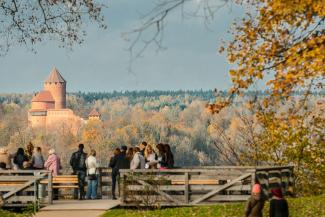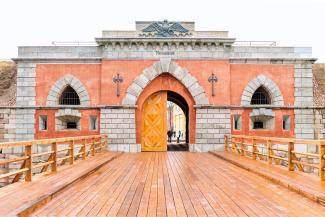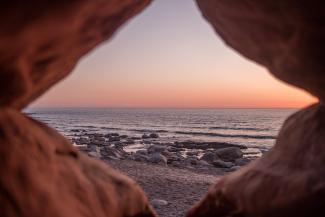Szymon Nitka is a Polish travel blogger and expert cyclist. He travelled through Latvia by bike in May 2018 and documented his adventures.
The Baltic States - Lithuania, Latvia and Estonia - for mature generations of Poles are associated with the past image of the former Soviet republics. If we travel to the north, the destination is mainly Scandinavia with Finland. Even bicycle travelers don't leave the main road corridor around the Baltic Sea on their way to Nordkapp. In spite of these trends, after a week of cycling around Latvia, Latvia left in me a memory of culturally and historically interesting country, well-kept, full of lush nature and kind people.
When I asked cycling friends what they recall from Latvia from their bicycle trip around the Baltic Sea, the answer was mainly Riga with its impressive Old Town and... long, boring journeys along the main routes. But part of Latvia is also the former Polish region called Inflanty Polskie, today inhabited by a large and active Polish diaspora, living in the being highly depopulated east of the country. Latvia is also a huge part of the history of the medieval Hansa, to which we have a lot of luck during the last trips in Germany. It is also a kilometer long wide, empty, sandy beaches on the Baltic Sea. Worthy of note is the internal Latvian-Russian social relations and the said migration processes. And the traditional black balsam from Riga - the variant with blackcurrant especially.
Getting the bicycle to Latvia
The Latvian airline Air Baltic makes it easier to travel to Latvia - it is one of the few that approach liberally to the issue of bicycle packaging. Instead of putting it apart and securing it in various ways inside the cardboard box, this time it was enough to unscrew the steering wheel and pedals, drain the air from the wheels and give it - as always - in the gate servicing oversized luggage. And soon, with real pleasure, I could observe how a Gdansk airport operator is leading my bicycle to the plain. And then the same procedure to go in Riga. Both flights went unscathed and each time the preparations for its sending were about a quarter of an hour.

Cycling in East Latvia
Today Latgalia is the former Polish Inflanty Polskie, and Rēzekne once bore the Polish name of Rzeżyca. Almost 200 years of Polish rule in these lands left many traces of our countrymen. Polish schools, Polish plaques at cemeteries and memorials, former Polish owners of worth visiting objects, and above all even about 15% of today's inhabitants of these lands, calling themselves Poles. Part of the exhibition at the museum in Krasław tells about the Polish part of the city's history. Even the headquarters of the Union of Poles in Latvia is located not in the capital of Riga, but in Latgale, in the second largest city of the country - Daugavpils. An interesting fact is that Daugavpils is the birthplace of Teresa Czerwińska, the current minister of finance in the rightist Polish government of Mateusz Morawiecki.
Lūznava Manor
Among the places that were created, thanks to the Polish inhabitants of these lands is beautiful, hidden in the woods near the village of Lūznava (former Polish Dłużniewo) manor, to which from Rēzekne ran the first several kilometers of my Latvian expedition. The mansion was designed by the Polish engineer and general of the Russian army Stanisław Kierbedź in the Art Nouveau style and was built in 1911 after his death by his daughter Eugenia. The former manor house of Kierbedź family, reconstructed with the aid of the European Union, contrasts today with the buildings of closed plants in the center of the village.
Road conditions
In the National Park Raźno and in Latgale I ride on wide gravel roads, without which it could be difficult to imagine a bicycle journey through the Baltic states. However, on the first day I am positively disappointed with the convenience of cycling. Due to the really low volume of car traffic in this part of the country, most of the gravel roads are very decent quality, and the "grate" that can be created sometimes can be always bypassed, while the "sandbox" completely preventing the ride has never met by me in Latgalia. I encountered more difficulties like this later, on the Baltic stretch of my route. And after leaving gravel route for the tarmac one before Aglona, I was surprised by the fact that maybe even 3 out of 4 truck drivers passed me with great respect on the left side of the road. And it is worth adding that trucks are seen here definitely more than passenger cars.

Daugavpils Fortress
One of the most unusual things during my trip was an amazing fortress built by the Russians over Daugava. Started after the acquisition of Inflants from Poles, the construction ended in 1878 with the creation of a fortified small town, where they hosted, among others, Tsars Alexander I, Nicholas I, Alexander II, Alexander III and Nicholas II. Today, Latvians boast of the Daugavpils fortress as the only such well-preserved building of this type and size in Europe. Indeed, it did not want to fit into the eye of the still fading away drone camera.
North Latvia Shoreline
The impressive Riga is already known by many tourists, but few are visiting the intimate, shapely Baltic coast in the Vidzeme region north of Riga. The small cliffs do not dazzle with scale and majesty, as we know it from Kępa Redłowska in Poland, but they enchant the intricately carved in the sandy shore with small hollows and grottos. A delicate natural creation created by - it might seem - a clumsy Baltic sea is located about 10 kilometers north of the village of Tūja and is one of the most characteristic places on the Latvian coast, while being a very interesting geological object.
On the same stretch of the Baltic coast is the old, tiny Kurmrags lighthouse. Submitted by deceitful currents, for years thrown from a small cliff into the water, today it flexes again in the light of the moon on a rocky Baltic beach and works on the brand of this most famous object on the northern coast of Latvia. It is best to get here directly by the beach, because I could not find a narrow passage between private properties from the road along the sea, which some of the reports mention. Despite the stony-sandy beach type in this section, a short bicycle ride should not be a problem.
EuroVelo 10 and 13
Two routes of the European EuroVelo network run along the coast of Latvia. To see the most beautiful places on the north coast, leave EuroVelo 10 called the Baltic Sea route and follow the EuroVelo 13 signs - a route along the former European "Iron Curtain". Both European routes are undoubtedly the most frequently chosen ways of cycling through Latvia, but you can't see the real Latvia in that way. It would be like... licking the paper from the popular chocolate cottage cheese, which in the local hypermarkets occupy entire cold stores! Additionally, the "twisted" way of leading the EuroVelo routes through Latvia means, that most cyclists who rush to Nordkapp will ignore many of the side episodes and will not see all the interesting places of Latvia.

And that's what Latvia is. On the one hand, tempting with convenient transport aboard the 4th most punctual airline of the world, on the other showing its natural attractions from gravel, sometimes heavily dusty roads in the east of the country. And everywhere - just, I almost forgot! - in each of the Latvian cities in which I was, one remembers about cyclists and offers them either decent bicycle routes (Riga, Daugavpils), or designated lanes on the road, or at least walking and cycling routes. Both of them with such a large number of comfortably leveled curbs at the crossings and intersections that I have never seen before, neither in Poland nor even in any city in Germany.
Author





